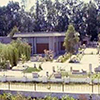
The idea of exhibiting the opuses belonging to the region in a location in the district that is rich in terms of archeology belongs to the authorities of that period at the beginning of 1960s and the first core of the museum has occurred in those years. After that, large scaled stone opuses collected from the surrounding have been protected in a depot; with the building constructed in 1987, contemporary museum understanding became dominant and the opuses have been served to the visitors. Fethiye Museum consists of two halls, one for archeology and the other for ethnography. Almost all of the opuses exhibited in these two halls have been compiled from Fethiye and its surroundings.
A big part of the opuses being exhibited in the archeology part consists of ceramic group opuses. The opuses in the hall have been subjected to a chronological order among themselves. Most important of the opuses covering the period from 3000 BC to the end of the Byzantine period is undoubtedly the stel that had great contributions in decoding Likian language. There is a text on this stel which is written in three different languages. Another important opus of the museum is the "Sculpture of Young Girl with Dove" and the sculpture of two women beside it. The sculpture of the girl with dove is related with Arthemis cult and it is important in terms of its showing the existence of an Arthemis temple in the city in ancient period.
In the ethnography hall, there are various hand weaving samples, hand embroideries, robes, uc etek (a kind of dress worn by women), and silver jewelry special to the region. In addition, a dastar loom that is in active condition with all its units is also exhibited in this part. In the open part of the museum, large stone blocked opuses, sarcophagus graves and "Izraza Monument", which is a product of Lichean culture are exhibited.
 The idea of exhibiting the opuses belonging to the region in a location in the district that is rich in terms of archeology belongs to the authorities of that period at the beginning of 1960s and the first core of the museum has occurred in those years. After that, large scaled stone opuses collected from the surrounding have been protected in a depot; with the building constructed in 1987, contemporary museum understanding became dominant and the opuses have been served to the visitors. Fethiye Museum consists of two halls, one for archeology and the other for ethnography. Almost all of the opuses exhibited in these two halls have been compiled from Fethiye and its surroundings.
The idea of exhibiting the opuses belonging to the region in a location in the district that is rich in terms of archeology belongs to the authorities of that period at the beginning of 1960s and the first core of the museum has occurred in those years. After that, large scaled stone opuses collected from the surrounding have been protected in a depot; with the building constructed in 1987, contemporary museum understanding became dominant and the opuses have been served to the visitors. Fethiye Museum consists of two halls, one for archeology and the other for ethnography. Almost all of the opuses exhibited in these two halls have been compiled from Fethiye and its surroundings.